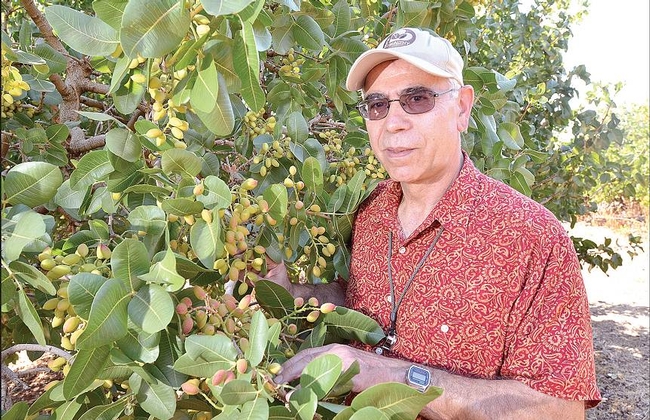Posts Tagged: Pomegranates
Promenade in the Pomegranates
What a match--honey bees and pomegranate blossoms. Watching the golden bees forage amid the...

A backlit honey bee heads for a pomegranate blossom. (Photo by Kathy Keatley Garvey)

Caught in flight, a honey bee makes a beeline to a pomegranate blossom. (Photo by Kathy Keatley Garvey)

The nectar of the gods. (Photo by Kathy Keatley Garvey)
KARE scientist visits Australia to share insights into disease control and food safety strategies for tree nut crops.
Themis Michailides, plant pathologist and lecturer in the Department of Plant Pathology at UC Davis, and Kearney Agricultural Research and Extension Center, recently visited Australia, primarily to visit pistachio and almond orchards and discuss disease control and food safety strategies for these crops.
In 2011, Australia had excessive rains at harvest time, which resulted in pistachio crop losses of 40 to 50 percent due to anthracnose fungi. The lost crop was worth about $15 million. To help prevent the problem in the future, the growers went to California to get input on current disease management strategies. Themis Michailides’ research and extension program was very helpful. As a result, the pistachio and almond crop growers of Australia created protocols to prevent and control the disease. The Australian Pistachio Industry invited Dr. Michailides to tour the Riverland and Sunraysia regions this year to inspect orchards that were previously affected by the anthracnose as well as meet with Australian researchers.
Dr. Michailides was surprised to find lower limb dieback in Australia. This is a problem that his program studied in California for many years with funds from the Californian Almond Board.
The trip was mutually beneficial. The Australian industry and researchers received expert advice and Dr. Michailides learned about practices in Australia that can benefit his research and extension program in California.
Highlights of the trip are summarized below.
- Brisbane: met with Australian plant pathologists from the local area and discussed many plant diseases of interest to the local region.
- Adelaide: stayed and enjoyed visiting with his UC Davis classmate Prue McMichael’s family; visited local laboratories and research organizations to discuss pistachio, pomegranate and almond disease control and food safety strategies.
- Mallee and Riverland regions: met with growers and researchers to discuss disease control and food safety strategies for pistachios and almonds. Displayed samples of Anthracnose and Botryosphaeria infected nuts and leaves that were collected during Dr. Michailides’ Australian orchard visits.
- Mildura: met with the Australian Pistachio Research and Development Committee and discussed some of the pistachio disease control efficacy research being done in Australia. Recommended that the committee access “Fungicides, Bactericides, and Biologicals for deciduous Tree Fruit, Nut, Strawberry, and Vine Corps 2012” to review current pest management strategies for tree fruit, tree nut, strawberry and vine crops. Shared how to closely inspect trees, bark, wood, leaves and nuts to identify and diagnose symptoms of various diseases, as well as predict disease risks based on inoculum levels and weather conditions.

Dr. Themis Michailides inspecting pistachio trees in Australia for disease symptoms. (Photo courtesy of The Murray Pioneer Pty. Ltd.)
Californian pomegranates bound for Korea
UC and USDA APHIS recently presented a program at Kearney Agricultural Research and Extension Center (KARE) addressing the requirements for the export of California pomegranates to the Republic of Korea. James E. Adaskaveg, professor in the Department of Plant Pathology at UC Riverside presented information on the management of insects and pathogens on the Korean quarantine list. Magdalena Moreno from APHIS provided information on regulatory documentation required for exporting pomegranates to Korea. The event was attended by 60 growers, packers, shippers and others interested in the export of pomegranates. There have been over 1.3 million cartons of California pomegranates exported to Korea in each of the last two years.

Field day participants looking at a pomegranate tree in a KARE field
Bee-ing Thankful
President Obama just pardoned a couple of turkeys--Apple and Cider. They won't make it to the White...

Bee on Pomegranate Blossom

Close-Up
Citrus, Persimmons, and Pomegranates
Our freezing December temperatures could possibily cause frost damage to your citrus. Here is a link to information on how to provide freeze protection for your citrus. http://groups.ucanr.org/mgfresno/Garden_Questions/December.htmEven though your citrus may have been damaged it is still ok for consumption for a couple of weeks. Why not pick your extra fruit, box it up and take it to your nearest food pantry? There are many families in need of food this winter. Here is the link to Fresno Master Gardener's PAR website: http://groups.ucanr.org/mgfresno/PAR/ for a list of local food pantries.
There is also an abundance of persimmons and pomegranates this time of year. They can also be dropped off at your nearest food pantry.